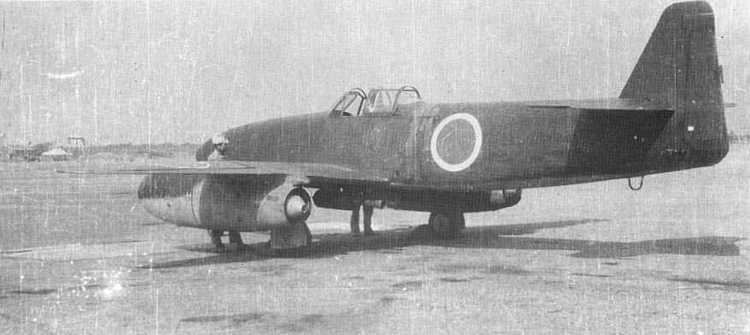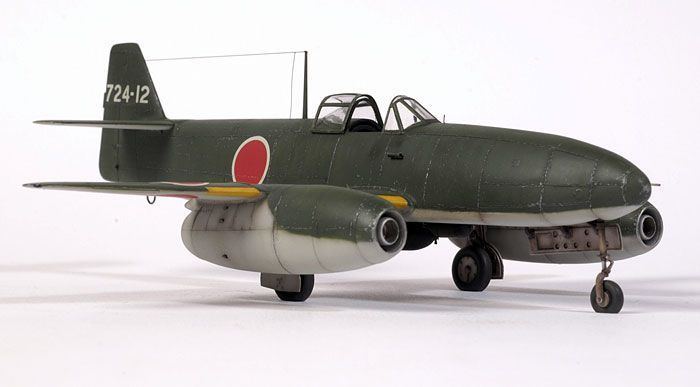Top speed 695 km/h Wingspan 10 m | Range 937 km Length 9.25 m First flight August 7, 1945 | |
 | ||
Engine types Ishikawajima Ne-20, Turbojet | ||
The Nakajima Kikka (中島 橘花, "Orange Blossom") was Japan's first jet-powered aircraft. It was developed late in World War II and the first prototype had only flown once before the end of the conflict. It was also called Kōkoku Nigō Heiki (皇国二号兵器, "Imperial Weapon No.2").
Contents
- War thunder sim nakajima kikka a plane is only as good as it s pilot sim air gameplay
- Design and development
- Aircraft Designation Clarification
- Operational history
- Postwar
- Variants
- Operators
- Specifications
- References

War thunder sim nakajima kikka a plane is only as good as it s pilot sim air gameplay
Design and development

After the Japanese military attaché in Germany witnessed trials of the Messerschmitt Me 262 in 1944, the Imperial Japanese Navy issued a request to Nakajima to develop a similar aircraft to be used as a fast attack bomber. Among the specifications for the design were the requirements that it should be able to be built largely by unskilled labor, and that the wings should be foldable. This latter feature was to enable the aircraft to be hidden in caves and tunnels around Japan as the navy began to prepare for the defense of the home islands. Nakajima designers Kazuo Ohno and Kenichi Matsumura laid out an aircraft that bore a strong but superficial resemblance to the Me 262.

The Kikka was designed in preliminary form to use the Tsu-11, a very crude thermojet style of jet engine that was little more than a ducted fan with an afterburner. Subsequent designs were planned around the Ne-10 (TR-10) centrifugal-flow turbojet, and the Ne-12, which added a four-stage axial compressor to the front of the Ne-10. Tests of this powerplant soon revealed that it would not produce anywhere near the power required to propel the aircraft, and the project was temporarily stalled. It was then decided to produce a new axial flow turbojet based on the German BMW 003.

Development of the engine was troublesome, based on little more than photographs and a cut-away drawing; but a suitable unit, the Ishikawajima Ne-20, was finally built. By mid-1945, the Kikka project was making progress once again and at this stage, reflecting the deteriorating war situation, it is possible that the Navy considered employing the Kikka as a kamikaze weapon although the prospect was questionable due to the high cost and complexity associated with contemporary turbojet engines. As well, other more economical projects meant specifically for the role such as the simple Nakajima Tōka (designed to absorb Japanese stock of obsolete engines), the pulsejet-powered Kawanishi Baika, and the infamous Yokosuka Ohka, were either underway or already in mass production.

Compared to the Me 262, the Kikka airframe was noticeably smaller and more conventional in design, with straight (rather than swept) wings and tail surfaces. The triangular fuselage cross section characteristic of the German design was less pronounced, due to smaller fuel tanks. The main landing gear of the Kikka were taken from the A6M Zero and the nose wheel from the tail of a Yokosuka P1Y bomber.
Aircraft Designation Clarification
The Kikka is often identified as the Nakajima J9N1, or occasionally J9Y, which according to a researcher at the National Air and Space Museum is incorrect. The official name given to the aircraft was 橘花 "Kitsuka," pronounced Kikka in Chinese character Kanji used traditionally by the Japanese. Like other Japanese aircraft intended for use in suicide missions, it received only a name. Imperial Japanese Naval aircraft were designated similar to U.S. Naval aircraft of the time frame. A first letter, denoting the role/type of aircraft, separated by a number that denotes where in the series of aircraft of the same role the aircraft resides, followed by a second letter denoting the design and manufacturing firm, and finally, a second number denoting the aircraft subtype. The first three characters remain constant through all the sub-variants an aircraft might be built to.
Operational history
The first prototype commenced ground tests at the Nakajima factory on 30 June 1945. The following month it was dismantled and delivered to Kisarazu Naval Airfield where it was re-assembled and prepared for flight testing. The first flight took place on 7 August 1945, with Lieutenant Commander Susumu Takaoka at the controls. The aircraft performed well during a 20-minute test flight, with the only concern being the length of the takeoff run. For the second test flight, four days later, rocket assisted take off (RATO) units were fitted to the aircraft. The pilot had been uneasy about the angle at which the rocket tubes had been set, but with no time to correct them they decided to simply reduce the thrust of the rockets from 800 kg to only 400 kg. Four seconds into take off the RATO was actuated, immediately jolting the aircraft back onto its tail leaving the pilot with no effective tail control. After the nine-second burning time of the RATO ran out the nose came down and the nose wheel contacted the runway, resulting in a sudden deceleration, however both engines were still functioning normally. At this point the pilot opted to abort the take off, but fighting to brake the aircraft and perform a ground loop only put him in danger of running it into other installations. Eventually the aircraft ran over a drainage ditch which caught the tricycle landing gear, the aircraft continued to skid forward and stopped short of the water's edge. Before it could be repaired Japan had surrendered and the war was over.
At this point, the second prototype was close to completion, and between 18 and 25 more airframes were under construction. One of these was a two-seat trainer. Other follow-on versions proposed had included a reconnaissance aircraft, and a fighter armed with two 30 mm Type 5 cannons with 50 rounds per gun. These were expected to be powered by more advanced developments of the Ne-20, known as Ne-20-Kai 5.59 kN (570 kgf) or Ne-130 8.826 kN (900 kgf) or Ne-230 8.679 kN (885 kgf) or Ne-330 13.043 kN (1330 kgf), which were planned to have approximately 15% to 140% better thrust than the Ne-20.
Postwar
After the war, airframes 3, 4, and 5 (and possibly other partial airframes) were brought to the U.S. for study. Today, only a single example survives in the National Air and Space Museum: a Kikka that was taken to the Patuxent River Naval Air Base, Maryland for analysis. This aircraft is very incomplete and is believed to have been patched together from a variety of semi-completed airframes.
Two Ne-20 jet engines had been taken to the US and sent for analysis to the Chrysler Corporation in 1946. This was only revealed in 2005 by W.I. Chapman, who was in charge of the project at the time. A working engine was assembled with the parts of the two Ne-20s, and tested for 11 hours and 46 minutes. A report was issued on 7 April 1947, titled "Japanese NE-20 turbo jet engine. Construction and performance". The document is now on display at the Tokyo National Science Museum.
Variants
Nakajima Aircraft Company developed some variants of the aircraft:
There was also a modified version of the design to be launched from a 200 m long catapult, the "Nakajima Kikka-kai Prototype Turbojet Special Attacker". This differed in having a projected total weight of 4,080 kg and a maximum speed of 687 km/h at 6,000 m.
Operators
Specifications
General characteristics
Performance
Armament
